Everything is moving to, or has already gone to, the cloud. And by cloud, we mean the datacenters of the tech behemoths — i.e AWS, Azure, Google, Equinix, Oracle, and others. More specifically, the most visible side of cloud computing is its major public cloud actors and what is referred to as the “public cloud.” While these massive cloud services providers and a large part of their cloud competitors tend to grow in business volume and size, there is an unmistakable shift happening in how their customers are relying on these services to power their own businesses.
As more and more workloads and datasets are being uploaded onto cloud platforms, a move away from public cloud is also happening — and has been noticeable since about four years now. Here’s what’s currently taking place…
Public cloud comes with several benefits, the first one being the convenience of outsourcing IT operations and the complexity that comes with it. The very nature of public cloud, however, forces organizations to adapt to the cloud platform they rely on and to rewrite some or all of their own applications to be cloud native. While this is far from being a bad idea in its own right, it does not really solve an organization’s problems — nor does it do anything to reduce their costs. By moving all or some of their infrastructure back from the public cloud to a private cloud or on-premises, or even choosing to split their workloads among several public cloud service providers, organizations are able to take advantage of the best of both worlds, while effectively dealing with the downsides of each option. This trend is usually referred to as the hybrid cloud.
In order to take advantage of all these options, it is necessary to understand that there are a few key tools that are capable of empowering organizations to run and migrate their systems and applications from one type of infrastructure to another.
#cloud services #hybrid cloud #cloud
